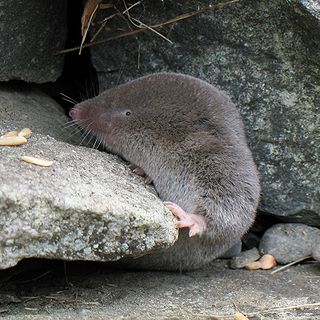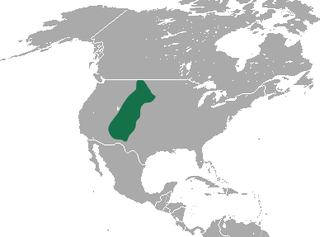
Shrews are small mole-like mammals classified in the order Eulipotyphla. True shrews are not to be confused with treeshrews, otter shrews, elephant shrews, West Indies shrews, or marsupial shrews, which belong to different families or orders.

The red-toothed shrews of the subfamily Soricinae are one of three living subfamilies of shrews, along with Crocidurinae and Myosoricinae. In addition, the family contains the extinct subfamilies Limnoecinae, Crocidosoricinae, Allosoricinae and Heterosoricinae. These species are typically found in North America, northern South America, Europe and northern Asia. The enamel of the tips of their teeth is reddish due to iron pigment. The iron deposits serve to harden the enamel and are concentrated in those parts of the teeth most subject to wear. Members of the genera Chimarrogale, Nectogale, Neomys (Nectogalini) and some members of Sorex (Soricini) are known as water shrews, due to having a semi-aquatic lifestyle.

The northern short-tailed shrew is the largest shrew in the genus Blarina, and occurs in the northeastern region of North America. It is a semifossorial, highly active, and voracious insectivore and is present in a variety of habitats like broadleaved and pine forests among shrubs and hedges as well as grassy river banks. It is notable in that it is one of the few venomous mammals. The specific epithet, brevicauda, is a combination of the Latin brevis and cauda, meaning "short tail".

The cinereus shrew or masked shrew is a small shrew found in Alaska, Canada, and the northern United States. This is the most widely distributed shrew in North America, where it is also known as the common shrew.

The American pygmy shrew is a small shrew found in Northern Alaska, Canada, and the northern United States, south through the Appalachian Mountains. It was first discovered in 1831 by naturalist William Cane in Georgian Bay, Parry Sound.

The Arctic shrew, also known as the blackback shrew or saddlebacked shrew, is a medium-sized shrew found in Canada and the northern United States. Separate species status has been proposed for the maritime shrew which is found in New Brunswick and Nova Scotia and had been considered to be a subspecies of the Arctic shrew. The tundra shrew was formerly considered to be a subspecies of the Arctic shrew.

The marsh shrew, also known as the Pacific water shrew, Bendire's water shrew, Bendire's shrew and Jesus shrew is the largest North American member of the genus Sorex. Primarily covered in dark-brown fur, it is found near aquatic habitats along the Pacific coast from southern British Columbia to northern California. With air trapped in its fur for buoyancy, marsh shrews can run for three to five seconds on top of the water. It measures about 16 cm (6.3 in) in length, including a 7-centimetre (2.8 in)-long tail, and weighs an average of 14.5–16 g (0.51–0.56 oz). The marsh shrew's diet consists mainly of invertebrates, which it hunts on land and in the water. They are rare; their populations are thought to be in decline, and they are considered endangered in parts of their range.

The smoky shrew is a medium-sized North American shrew found in eastern Canada and the northeastern United States and extends further south along the Appalachian Mountains.

The southern short-tailed shrew is a gray, short-tailed shrew that inhabits the eastern United States.

The genus Sorex includes many of the common shrews of Eurasia and North America, and contains at least 142 known species and subspecies. Members of this genus, known as long-tailed shrews, are the only members of the tribe Soricini of the subfamily Soricinae. They have 32 teeth.

The Eurasian pygmy shrew, often known simply as the pygmy shrew, is a widespread shrew of the northern Palearctic.

The common shrew, also known as the Eurasian shrew, is the most common shrew, and one of the most common mammals, throughout Northern Europe, including Great Britain, but excluding Ireland. It is 55 to 82 millimetres long and weighs 5 to 12 grams, and has velvety dark brown fur with a pale underside. It is one of the rare venomous mammals. Juvenile shrews have lighter fur until their first moult. The common shrew has small eyes, a pointed, mobile snout and red-tipped teeth. It has a life span of approximately 14 months.

Elliot's short-tailed shrew is a small, slate grey, short-tailed species of shrew. Its common name comes from Daniel Giraud Elliot, who first described the species in 1899.

Sorex ornatus sinuosus, the Suisun shrew or Suisun ornate shrew, is a subspecies of the ornate shrew that occurs in the tidal marshes of the northern shores of San Pablo and Suisun bays. Brown and Rudd redefined the western boundary of the range from a prior designation of the Petaluma River. The Suisun shrew has been designated as a Species of Concern by the U.S. government and a Mammalian Species of Special Concern by the state of California.

The montane shrew is a species of mammal in the family Soricidae commonly known as the dusky shrew. Monticolus is derived from the Latin root word mons meaning mountain. It is found in Alaska, western Canada, the western United States in Washington, Idaho, Montana, Utah, Colorado, New Mexico, Arizona, Oregon, Nevada, and California, as well as in Mexico.

The dwarf shrew is a species of mammal in the family Soricidae endemic to Arizona, Colorado, Montana, Nebraska, New Mexico, South Dakota, Utah, and Wyoming in the United States. The type locality is Estes Park, Colorado, USA.

The ornate shrew is a species of mammal in the family Soricidae (shrews). It is endemic to western North America, ranging from Northern California in the United States to Baja California in Mexico. Eight subspecies are known, including the extinct tule shrew, known only from four specimens collected in 1905, and the Suisun ornate shrew, a species of conservation concern in California. Through skull morphology research and genetic testing on Ornate shrew populations, it has been shown that there are three main genetic subdivisions: The Southern, Central and Northern. These three genetic subdivisions of Ornate shrew arose from populations of Ornate shrews getting geographically isolated from other populations.

The Inyo shrew is a species of shrew found in the western United States. It is light gray and white in color, with a narrow skull and small body size, very similar in appearance to the related dwarf shrew, but paler and not as large. It can be found in many different habitats, from rocky, mountainous regions to wetlands and riparian areas. Not much is known about its behavioral and reproductive habits. While barely studied, their population is believed to be stable and not under any threat.

Trowbridge's shrew is a species of mammal in the family Soricidae. It is found in southern British Columbia in Canada and in Washington, Oregon, and California in the United States.

The long-tailed shrew or rock shrew is a small shrew found in Atlantic Canada and the Northeastern United States.




















